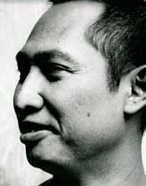 |
||
|---|---|---|
| CP Foundation | About CP Biennale | 2003 | 2005 | Contact Us | >||
           
|
||
|
Nindityo's works involving exploration of konde as a theme can be seen, more or less, as a kind of introspection. This attitude is, of course, only appropriately understood within the context of the fact that the artist originates from a Javanese background, even though -- as Nindityo has noted – this presentation of introspective thinking is not always fully beneficial. The problem is how to lift this specific phenomenon into a more universal context. His works focused on the konde are not necessarily critiques of the Javanese culture from whence he came because he is not immediately concerned with preparing himself as a moralist who carries about a burden of morality. The substance of the konde theme remains relevant to this current work of art under discussion, at least on the surface of the matter. In this particular work, Nindityo has gone even deeper than ever before into the creative awareness that is represented in each and every one of his works. An interesting thing to note in relation to this particular exhibition is that the treatment of the subject matter of his work seems to be more focused than ever before on interaction with the viewers of the artwork. The whole surface of the wood has been made monotonous through the presentation of the repetitive pattern of the forms of small boxes. This material is presented to the viewer as not just something to look at, but also as something that can be stepped on after taking one's shoes off. This work will produce significant meanings, while also providing a motor experience through physical sensations. This is particularly true if the importance of the nerves in the soles of the feet is fully understood. Within this process of interaction between his artwork and the public, Nindityo is presenting a paradox. The pieces of wood that form the large flat konde shape are not in the actual "sacral" position of the konde itself, which would be on the head, or elevated to a specific level, rather than being placed on the floor where it can be stepped on by just anyone wanting to experience a sensation through the soles of the feet. This time, Nindityo's konde is quite healthy. Kuss Indarto Born on June 24, 1961 in Semarang. SELECTED SOLO EXHIBITIONS SELECTED GROUP EXHIBITIONS |
||
|
CP Foundation | About CP Biennale | 2003 | 2005 | Contact Us
Jl. Suryopranoto 67A, Jakarta 10160, Indonesia. ph. +62.21.3448126, 3853206 | fax. +62.21.3853203, 3853208 info@cp-foundation.org |
||
 The pieces of wood and other materials are neatly arranged. If carefully observed from above, these materials seem to be arranged into two formations. The first formation, in the smaller circle, seems to set out the image of a meeting between the linggo (male genitals) and the yoni (female genitals). In the second formation, the circle encircling the first circle takes the shape of a large konde (traditional feminine hairpiece in the shape of an oval bun, which is usually pinned at the back of the head). Most of Nindityo's works present a duality of forces: between beauty and taste on the surface as a representation of unity, while the more latent force derives from various secretive central issues that are set forth only to be ignored or broken like unaccepted rules.
The pieces of wood and other materials are neatly arranged. If carefully observed from above, these materials seem to be arranged into two formations. The first formation, in the smaller circle, seems to set out the image of a meeting between the linggo (male genitals) and the yoni (female genitals). In the second formation, the circle encircling the first circle takes the shape of a large konde (traditional feminine hairpiece in the shape of an oval bun, which is usually pinned at the back of the head). Most of Nindityo's works present a duality of forces: between beauty and taste on the surface as a representation of unity, while the more latent force derives from various secretive central issues that are set forth only to be ignored or broken like unaccepted rules.